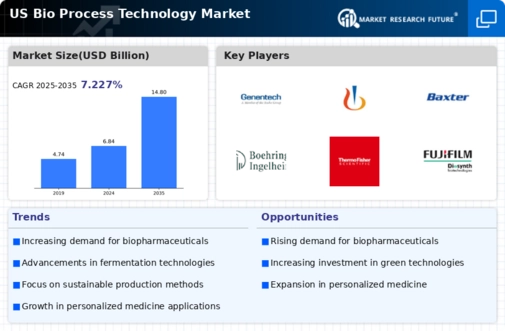Rising Demand for Biopharmaceuticals
The bio process-technology market is experiencing a notable surge in demand for biopharmaceuticals, driven by an increasing prevalence of chronic diseases and a growing aging population in the US. This demand is reflected in the market's projected growth, with estimates suggesting a compound annual growth rate (CAGR) of approximately 8% over the next five years. The bio process-technology market plays a crucial role in the development and production of biologics, which are essential for treating various health conditions. As healthcare providers and patients seek more effective therapies, the bio process-technology market is likely to expand, fostering innovation and investment in biopharmaceutical manufacturing processes.
Growing Focus on Personalized Medicine
The bio process-technology market is witnessing a growing focus on personalized medicine, which tailors treatments to individual patient profiles. This trend is driven by advancements in genomics and biotechnology, enabling the development of targeted therapies. The market for personalized medicine is projected to reach $2 trillion by 2030, indicating a substantial opportunity for bio process-technology applications. As healthcare providers increasingly adopt personalized approaches, the demand for bioprocessing technologies that can efficiently produce customized biologics is likely to rise. This shift towards personalized medicine not only enhances patient outcomes but also positions the bio process-technology market as a key player in the future of healthcare.
Investment in Research and Development
Investment in research and development (R&D) within the bio process-technology market is a significant driver of growth. The US government and private sector are increasingly allocating funds to advance bioprocessing technologies, with R&D expenditures reaching nearly $50 billion in recent years. This financial commitment is aimed at enhancing the efficiency and scalability of bioprocesses, which are vital for producing high-quality biological products. As breakthroughs in R&D emerge, they are expected to lead to improved production methods and novel therapeutic solutions, thereby propelling the bio process-technology market forward. The focus on innovation is likely to attract further investments, creating a robust ecosystem for bioprocessing advancements.
Environmental Regulations and Compliance
Environmental regulations and compliance requirements are becoming increasingly stringent, influencing the bio process-technology market. The US Environmental Protection Agency (EPA) has implemented various regulations aimed at reducing the environmental impact of bioprocessing operations. Companies in the bio process-technology market are compelled to adopt sustainable practices and invest in cleaner technologies to meet these regulations. This shift not only ensures compliance but also enhances the market's reputation and competitiveness. As organizations strive to minimize waste and emissions, the bio process-technology market is likely to evolve, integrating more eco-friendly processes and technologies that align with regulatory expectations.
Collaboration and Partnerships in Innovation
Collaboration and partnerships among stakeholders in the bio process-technology market are emerging as a vital driver of innovation. Academic institutions, research organizations, and industry players are increasingly joining forces to share knowledge and resources. This collaborative approach is fostering the development of cutting-edge bioprocessing technologies and methodologies. For instance, partnerships between biotech firms and universities have led to advancements in cell culture techniques and bioreactor design. Such collaborations not only accelerate the pace of innovation but also enhance the overall capabilities of the bio process-technology market. As these partnerships continue to grow, they are expected to yield significant advancements in bioprocessing efficiency and product quality.





















Leave a Comment